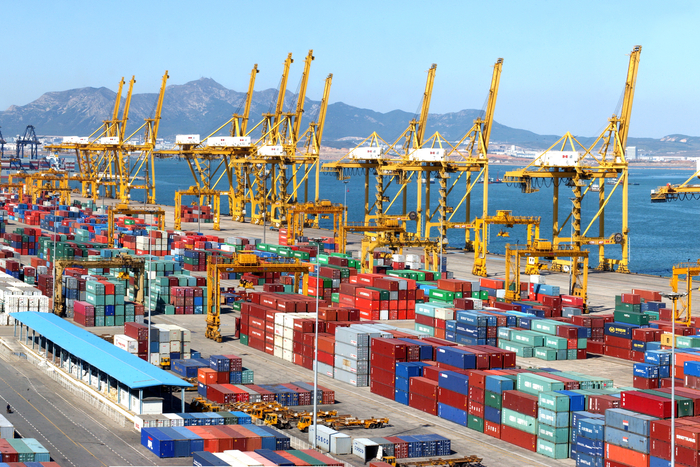
US ports may be entering a new era in which inventory replenishment driven by online shopping stresses port supply chains. Photo credit: Shutterstock.com.
US imports from Asia in January increased 14 percent from January 2020, extending the peak shipping season that began last July for an unprecedented seven consecutive months.
If import volumes remain near January’s level of 1.59 million TEU through the spring — as retailers, terminal operators and freight forwarders say is possible given the importance of e-commerce merchandise to the US trade from Asia — US gateways may be entering a new era in which retailers’ constant need for replenishment of inventories stresses port supply chains.
US containerized imports from the world totaled 2.29 million TEU in January, an increase of 12.2 percent from January 2020, according to PIERS, a JOC.com sister product within IHS Markit. Imports from China totaled 994,431 TEU, up 15.5 percent year over year. Imports from Asia in calendar year 2020 accounted for 67.4 percent of total US imports from the world, and imports from China accounted for 42.1 percent of total US imports, according to PIERS.

Click to enlarge.
The surge in imports from Asia that began in late June when the US lockdowns from the coronavirus disease 2019 (COVID-19) were lifted have strained the cargo-handling capabilities of ports on all three coasts. The major gateways have struggled with congested marine terminals, equipment shortages, and longer-than-usual truck-turn times.
In the past, when trans-Pacific shipping cycles were based on in-store shopping, containerized imports from Asia peaked in July through October, as they were tied to the back-to-school and holiday shopping seasons. Import volumes moderated in November and December, increased in January in the pre-Lunar New Year rush, and took a sizable dip in February and March when factories in Asia closed for the holidays.
E-commerce is now the major driver of US imports
Those seasonal dips in imports may be replaced by constant inventory replenishment due to consumer online shopping. Last summer, US imports bounced back from the first wave of COVID-19-related closures, reaching 1.5 million TEU in July and ranging from 1.5 million to 1.69 million TEU each month through January, according to PIERS. Strong import volumes are expected to continue into the summer because online purchasing by American consumers shows signs of slowing down.
Global Port Tracker, which is published monthly by the National Retail Federation and Hackett Associates, projects total US imports in February will increase 26.3 percent over February 2020. Imports are projected to increase 41 percent in March, 13.3 percent in April, 23.8 percent in May, and 18.2 percent in June from the same months last year. It should be noted that imports last spring were exceptionally low due to the COVID-19 economic lockdowns.
Los Angeles-Long Beach has experienced greater disruption than other US gateways in terms of vessel backlogs, congested marine terminals, and extended truck turn times. On Tuesday, there were 32 container ships at anchor awaiting berthing space and 26 container ships being worked at berth, according to the Marine Exchange of Southern California. Vessels at anchor in Los Angeles-Long Beach have ranged from 28 to 32 each day for months now.
US ports are not expected to experience the sharp drop in container volumes that occurred during past Lunar New Years. Non-vessel-operating common carriers (NVOs) report that plants in China will spend February and March reducing backlogs of product that are sitting on the factory floors. Some factories will attempt to maintain at least partial production in the coming month as China’s government, in order to curtail spread of the virus, has discouraged the massive migration of workers back to their home villages that normally occurs during the holidays.
Terminal operators in Los Angeles-Long Beach, however, told JOC.com they expect a slight dip in imports in the coming few weeks, which they say should contribute to reducing the vessel backlog. Also, they are hopeful that more dockworkers will be able to return to their jobs as vaccinations increase in Southern California. If this scenario plays out, terminal operators say Los Angeles-Long Beach could be back to fairly fluid operations sometime between April and June.
Contact Bill Mongelluzzo at bill.mongelluzzo@ihsmarkit.com and follow him on Twitter: @billmongelluzzo.
"asia" - Google News
February 18, 2021 at 10:17PM
https://ift.tt/3pydXEY
Surge of US imports from Asia in January extends peak into 2021 - JOC.com
"asia" - Google News
https://ift.tt/2YpEquI
https://ift.tt/2WkdbyX
Bagikan Berita Ini














0 Response to "Surge of US imports from Asia in January extends peak into 2021 - JOC.com"
Post a Comment